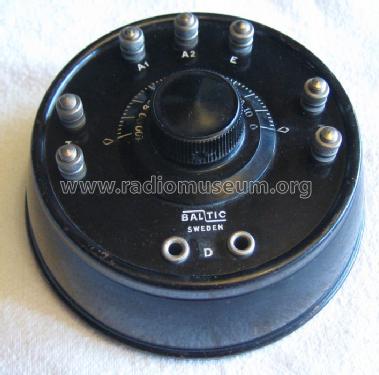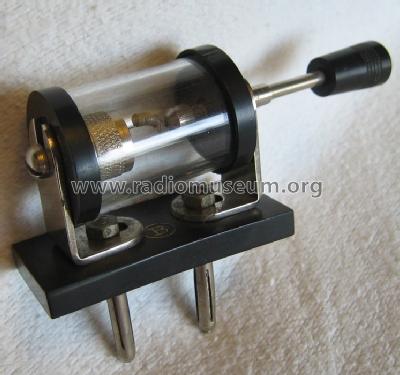Crystal Receiver M2
Baltic; Stockholm
- Paese
- Svezia
- Produttore / Marca
- Baltic; Stockholm
- Anno
- 1930 ??
- Categoria
- Radio a galena (a cristallo o a diodo, senza valvole o transistores)
- Radiomuseum.org ID
- 85618
- Principio generale
- Rivelazione a galena / semi-conducteur; Rivelazione a galena, 1 circuito RF
- N. di circuiti accordati
- 1 Circuiti Mod. Amp. (AM)
- Gamme d'onda
- Solo onde medie (OM).
- Tensioni di funzionamento
- Alimentazione non richiesta
- Altoparlante
- - Per cuffie o amplificatori esterni
- Materiali
- Mobile di metallo
- Radiomuseum.org
- Modello: Crystal Receiver M2 - Baltic; Stockholm
- Annotazioni
- Konische Dosenform, Ø unten 120 mm, oben 100 mm. Material: Messingblech. Variometer-Abstimmung.
Es gibt von diesem Modell 3 Ausführungen für 3 Mittelwellenbereiche die sich nur in den Abstimmungs-Induktivitäten unterscheiden.
- Peso netto
- 0.3 kg / 0 lb 10.6 oz (0.661 lb)
- Fonte dei dati
- - - Data from my own collection
- Autore
- Modello inviato da Christian Wirth. Utilizzare "Proponi modifica" per inviare ulteriori dati.
- Altri modelli
-
In questo link sono elencati 48 modelli, di cui 26 con immagini e 5 con schemi.
Elenco delle radio e altri apparecchi della Baltic; Stockholm
Collezioni
Il modello Crystal Receiver fa parte delle collezioni dei seguenti membri.
Discussioni nel forum su questo modello: Baltic; Stockholm: Crystal Receiver M2
Argomenti: 1 | Articoli: 4
I have a receiver that looks exactly like the M2 although I cannot find any number on it. I have some remarks on this model:
I do not beleive it is as late as 1930. Baltic merged with AGA in the summer 1928 to form AGA-Baltic AB, a receiver marked Baltic would then be made before this. Baltic made advanced valve radios already in 1925-26, so even if they may have produced these crystal receivers in parallell with the valve ones, I believe it is an earlier product, my guess is as early as 1924-25.
My receiver has capacitive tuning, the condenser consisting of two copper plates with glimmer isolation between them, one fixed to the panel and one "spring loaded" that can be pressed against the fixed one by means of a threaded screw on the tuning knob axis. The frequency range is aproximately 270 to 550 kHz, the selectivity is quite bad and of course also the sensitivity as there is no amplification. The receiver would obviously need a strong local station to work reliably.
I enclose photos of my receiver and a wiring diagram.
Allegati
- Baltic crystal receiver (70 KB)
- Baltic M2 wiring (15 KB)
Bo Samuelsson, 26.Dec.06


